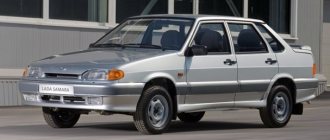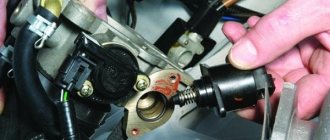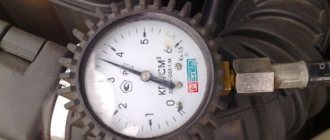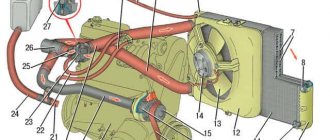Designation of icons on the dashboard of the VAZ 2115
The following describes the warning lights and panel indications, which are indicated and numbered in the photo above.
| Number in order | Decoding |
| 3/4 | Turn signal indicators. They light up at the same time when the alarm is activated. |
| 7 | Minimum fuel level light. Lights up when the gas tank is empty. |
| 8 | Indicator for turning on external lighting. |
| 9 | The brake system is faulty. The brake fluid level and pad wear should be checked. |
| 10 | The high beam headlights are activated. |
| 12/15 | Information displays, basic information about the daily time and mileage is displayed here. |
| 13 | Emergency light activation key. |
| 14 | Check engine light. If it lights up, further movement is not recommended. |
| 16 | The battery is low. The operation of the generator should be checked. |
| 17 | The indication indicates that the handbrake lever is raised. |
| 18 | The warning light means that the engine oil pressure has dropped below normal. |
| 19 | This indicator is used exclusively on carburetor cars. The light indicates that the throttle valve is in the open position. |
The structure of the instrument console of the VAZ 2115
The standard instrumentation of the VAZ 2115 is the same as on the 2113 and 2114 hatchbacks from the same Samara line. But the sedan body appeared earlier, simultaneously with the VAZ 2110. For the first time, AvtoVAZ began installing panels of a more modern type on cars of that time.
The shield is made according to the model of the manufacturer VDO. Its location is a torpedo, directly behind the steering wheel. It is informative and has 19 elements. Instrument color scheme: red and white light indicators on a black background.
The instrument panel on the VAZ 2115 is conventionally divided into four sectors in width. The left and right extreme parts are scales for coolant temperature and fuel quantity. The most important and voluminous parts of the VAZ 2115 instrument panel are the speedometer and tachometer. The first device shows the speed in kilometers per hour (located to the right). The second is an indicator of the number of crankshaft revolutions per minute (to the left of the center). They are made in the form of scales, the divisions of which are located on a circle.
Directly below the speedometer, the VAZ dashboard has an electronic odometer (mileage indicator). It shows two numbers:
- total vehicle mileage in kilometers;
- mileage from last reference point.
Zeroing is set by the driver using a manual switch, the location of which is under the number 200 on the speedometer. Under the tachometer on the dashboard there is an electronic display with the current time of day, and a button under the “200” indicator of the speedometer allows you to show the temperature outside the window. There are two arrows between the tachometer and speedometer (looking left and right). Each of them flickers green when the corresponding turn signal light is turned on.
The gasoline level scale on the VAZ instrument panel has three main positions. A full tank is designated “1,” and a half-filled tank is designated “1/2.” Next comes the red zone, which indicates a low fuel level. The scale ends with the number “0”. There are three main positions on the coolant level scale: 50, 90 and 130 degrees.
The red zone on the coolant level scale starts at 105 degrees. If the arrow is in this zone, it is necessary to immediately turn off the engine and ensure its normal cooling.
Tidy 2115: description and purpose of buttons and knobs
If everything is simple with the levers on the steering rack, there is a headlight position switch and a turn signal switch on the left. Buttons are more difficult.
On the dashboard, the main keys are placed in a separate “strip”. To understand the essence, we present their decoding from left to right.
- Switch for outside parking lights.
- Activation of low beam headlights.
- Front fog lights.
- Rear PTFs. If not installed, reserve.
- Rear window heating button.
Lada 2115: the oil light on the center panel is on
If an icon in the shape of a watering can appears on the console, this indicates that there are problems in the engine lubrication system. This is caused by a drop in the oil level in the crankcase or a pump malfunction. If the engine is old, the problem may be caused by clogged oil lines.
What does the exclamation mark on the Lada 2115 tidy mean?
On the "tag" the symbol is used in only one form - a red indicator in a circle. The icon indicates a malfunction in the vehicle's brake system. If this symbol lights up while driving, stop and find the cause of the breakdown. Usually it is enough to add fluid to the expansion tank or replace worn pads.
The battery light on the dash is on 2115
A red battery icon indicates that the battery is not charging properly. A complete diagnosis of on-board systems associated with the generator set and its wiring is required.
What is a dashboard?
The concept of “dashboard” is interpreted in different ways. Some argue that this is just an electronic panel with arrows, icons and scales. Others consider all the instruments on the dashboard to be a panel, on which a common cover is attached - the instrument panel, wiper arms, heater, air conditioner, ashtray, cup holder. The second option is the definition of “instrument cluster”.
The phrase “dashboard” implies a group of instruments that are combined by a common design.
| Such devices are considered: | What are they needed for: |
| speedometer | vehicle speed indicator; |
| tachometer | indicator of the number of crankshaft revolutions per unit of time; |
| odometer | numerical indicator of Lada mileage in kilometers; |
| pointers | provide information about the level of gasoline, pressure in the lubrication system, battery charge, coolant temperature; |
| sensors | characterize the braking system; |
| auxiliary elements | show current time, date, etc. |
The above designations are divided into control and measuring instruments and warning lamps. On the VAZ 2115, control and measuring devices are those devices that are indicated with scales and arrows. But in the simplified lexicon of motorists, the instrument panel (console) is usually called the entire part of the dashboard, which is covered by a cover on top and where any information is displayed, there are push-button and lever controls.
In this case, the main instrument panel refers to the instrument panel, which is located behind the steering wheel. The middle part, located above the gearshift lever, is in this case called the center console. And the levers and buttons for adjusting the lighting, cleaning the glass, and regulating the temperature are the controls. Everything is assembled - a VAZ 2115 instrument cluster.
The main instrument panel on the VAZ 2115 became one of the first VAZ panels of the modern VDO model.
How to check for errors on the device
The manufacturer has provided the ability for the driver to independently read faults without the presence of additional equipment.
To perform a self-diagnosis, you will need to follow a procedure.
- Sit in the driver's seat, insert the ignition key and press and hold the daily mileage reset button.
- Next, turn the ignition key in the lock, but do not start the engine.
- Release the reset button. Now the on-board computer self-diagnosis process will begin. This is accompanied by the inclusion of all lights and devices.
- Quickly press the mileage reset button again - this will display the version of the software used on the screen under the speedometer.
- If you press the button again, error codes will be displayed on the same screen.
1.1.28 Warning lamps
Warning lamps
| GENERAL INFORMATION |
| 1 – traction control system with reduction of engine torque or electronic stabilization system, 2 – turn signal when driving with a trailer, 3 – rear fog lights, 4 – electronic anti-theft system, 5 – direction indicator, 6 – high beam, 7 – airbag system security, | 8 – anti-lock brake system, 9 – parking brake, 10 – battery discharge, 11 – seat belts, 12 – coolant temperature/coolant level, 13 – engine oil pressure, 14 – brake system, 15 – brake pad wear , 16 – washer fluid, 17 – fuel reserve, 18 – pre-heater |
The location of the warning lamps on the instrument cluster depends on the vehicle model and engine version.
The pictograms presented in this description are available on the corresponding indicator lamps. 1 – Traction control with engine torque reduction (ASR)
The warning light comes on when the ignition is turned on and should go out after approximately 2 seconds. The lamp flashes when driving while the traction control system is activated. When the traction control system is turned off or when its operation is malfunctioning, the warning lamp lights up constantly. Since this traction control system works in conjunction with the anti-lock braking system and the traction control system, the ASR warning light also illuminates when the anti-lock braking system malfunctions.
1– Electronic stabilization system (ESP)
The warning light comes on when the ignition is turned on and should go out after approximately 2 seconds. Electronic stability control complements the traction control system by reducing engine torque. The lamp flashes while driving when the electronic stability control or traction control system is activated to reduce engine torque. When the system is turned off or if there is a malfunction in its operation, the indicator lamp lights up constantly.
Since the electronic stabilization system works in conjunction with the anti-lock braking system and also with the traction control system by braking the spinning wheel, when the anti-lock braking system fails, the warning lamp for the electronic stabilization system also lights up.
2 – Direction indicator when driving with a trailer
The warning lamp flashes together with the direction indicators on the vehicle and trailer. If one of the direction indicator lamps on a car or trailer fails, the indicator lamp does not blink.
3 – Rear fog lights
After turning on the rear fog lights, the warning light comes on.
4 – Electronic anti-theft system
When you turn on the ignition, the ignition key code is automatically requested. The comparison of data is confirmed by the short-term lighting of the control lamp. If an unauthorized key is used, the warning lamp starts flashing with short breaks. You cannot use a car.
5 – Direction indicator
Depending on which side of the vehicle the direction indicators are flashing, the left or right warning lamp flashes simultaneously. If one of the turn signal lamps fails, the indicator lamp flashes twice as fast as normal. This does not happen when towing a trailer.
6 – High beam
The indicator lamp lights up when the high beam is on and when a light signal is given.
7 – Airbag system
The warning lamp lights up after turning on the ignition for approximately 3 seconds. On vehicles with the front passenger airbag deactivated, the warning lamp flashes for approximately 12 seconds.
If the light does not go out or comes on while driving, the airbag system is faulty. Such a system must be immediately checked by a Volkswagen service center.
8 – Anti-lock braking system (ABS)
The warning lamp warns of a malfunction in the anti-lock braking system and in the traction control system with braking of a slipping wheel.
Anti-lock braking system (ABS)
The warning light comes on for a few seconds after the ignition is turned on or when the engine is started. It goes out after the process of automatically checking the system's functionality is completed.
If the warning lamp does not light up when the ignition is turned on, after a few seconds after turning on the ignition, it does not go out or lights up while driving, then the anti-lock braking system is not in order.
If there is a malfunction in the ABS, the following is possible:
– If only one anti-lock braking system warning light comes on while driving, the vehicle may still be braked by one normally functioning service brake system without an anti-lock braking system. You should contact a Volkswagen service company as soon as possible.
– If the anti-lock braking system warning light comes on together with the brake system warning light, this means that not only is there a malfunction in the ABS, but changes in the normal operation of the braking system should also be expected.
Warning
After both warning lamps come on, premature locking of the rear wheels is possible when braking.
You must immediately contact a Volkswagen service company. Traction control with wheel brake (EDS)
Traction control with wheel brake (electronically controlled differential lock) works in conjunction with ABS. A malfunction in the traction control system with braking of a spinning wheel is indicated by the ABS warning lamp coming on. It is necessary to contact a Volkswagen service company as soon as possible.
9 – Parking brake
When the parking brake is applied and the ignition is on, the warning light comes on. It should go out when the parking brake is released.
10 – Low battery
The warning light comes on when the ignition is turned on. It should go out after starting the engine. The generator is driven by a durable V-belt with ribs.
If the warning light comes on while driving, you must stop, turn off the engine and check the condition of the V-belt with ribs.
If the belt tension is weakened or the belt is broken, it is impossible to continue driving - the engine cooling system pump is no longer driven. The condition of the belt must be checked and the belt replaced if necessary.
If the warning light is on and the engine cooling pump drive belt is not loose or torn, you can continue driving to the nearest Volkswagen service center.
Since the battery is continuously discharging, you should turn off all those electrical consumers that are not required to be turned on.
11 – Seat belts
The warning light (export vehicles only) comes on for approximately 6 seconds after the ignition is turned on to remind you to wear your seat belts.
If the seat belts are not worn, a beep sounds after the ignition is turned on. It subsides after the seat belts are put on or after approximately 6 seconds.
12 – Coolant temperature/coolant level
The warning lamp lights up when the ignition is turned on for a few seconds - checking the functionality.
If the warning light does not go out or lights up or starts flashing while driving, this indicates either that the coolant temperature is too high or that the coolant level in the cooling system is too low.
As an additional warning, the horn will sound 3 times and you should stop the vehicle, turn off the engine and check the coolant level. If necessary, add coolant. Warning
Never open the engine hood when you see steam coming from the engine compartment or coolant leaking - risk of burns!
Make sure that your hands do not get into the fan rotation zone! The fan may suddenly start rotating – even with the ignition switched off!
To avoid being burned by high coolant temperatures, you should consider the following:
– be careful when opening the cap of the expansion tank of the cooling system! When the engine is hot, there is increased pressure in the cooling system. Therefore, before unscrewing the expansion tank plug, you should let the engine cool down; – to protect your face and hands from steam and hot coolant, cover the radiator cap with a sufficiently large piece of thick wiping material.
Make sure that coolant does not come into contact with hot parts of the exhaust system or other hot structural components. The low temperature additive contained in the coolant may ignite.
If the coolant level is normal, a malfunction of the cooling system may be caused by a faulty fan. Check the fan fuse and replace it if necessary.
If the warning light does not go out, although the coolant level is normal and the fan fuse is good, you should not continue driving - qualified assistance is required.
In the case where the cause lies in a fan malfunction and provided that the coolant level is normal and the warning light has gone out, you can continue driving to the nearest Volkswagen service center. In order to use the oncoming air flow to cool the liquid, idling the engine and driving at very low speeds should be avoided.
13 – Engine oil pressure
The warning lamp lights up for a few seconds when the ignition is turned on to check operation.
If the warning light does not go out, an audible signal sounds 3 times as an additional warning. The engine must not be started! You should check the engine oil level and add oil if necessary.
If the warning light comes on or flashes while driving, an acoustic signal sounds 3 times as an additional warning when the engine speed exceeds 1500 rpm. You must stop and turn off the engine! Check the oil level and add oil if necessary.
If the warning light flashes, despite the fact that the engine oil level is normal, you cannot continue driving. The engine should also not be idling.
The oil pressure warning light is not a means of monitoring the engine oil level! Therefore, you should check the oil level regularly, preferably every time you fill up with fuel.
14 – Brake system
The warning light comes on when the brake fluid level is too low.
The ignition must be turned on.
On vehicles with an anti-lock braking system (ABS), the warning light comes on for a few seconds after the ignition is turned on or the engine is started.
If the ABS fails, the brake system warning light lights up together with the ABS warning light. Warning
If, after starting the engine, the warning light does not go out or lights up while driving, this indicates that the level of brake fluid in the reservoir is too low.
You should immediately look for the nearest Volkswagen service center and check the working brake system. On the way there, you need to be prepared for the need to press the brake pedal harder when braking, for an increase in braking distance and for increased free play of the brake pedal. If the brake warning light illuminates together with the anti-lock braking system warning light, the rear wheels may lock up prematurely when braking. 15 – Brake pad wear indicator
You should contact a Volkswagen service center to check the condition of the brake pad linings.
Since the brake lining wear indicator indicates high wear on the front brake linings only, we recommend that you check the condition of the rear brake linings at the same time as replacing the front brake linings.
16 – Windshield washer fluid level
The warning light comes on when the level of windshield washer fluid in the reservoir is too low.
17 – Fuel capacity
The warning light comes on when the fuel supply drops to approximately 8 liters.
18 – Pre-heater
(only for vehicles with a diesel engine)
When the engine is cold, the warning light comes on when the driving position is switched on (“Ignition on”).
If the control lamp does not light up, then there is a malfunction in the preheater.
After the warning light goes out, you should immediately start the engine.
When the engine is warmed up to operating temperature, the warning lamp does not light up - you can start the engine immediately.
Warning
If, while driving a vehicle equipped with a diesel engine, problems occur in engine control, as indicated by a flashing warning light, the engine should be immediately checked by a Volkswagen service center.
The tidy and on-board computer 2115 do not work: reason
The engine may not start, but auxiliary devices such as power windows or wipers may work.
If this happens, you should check the points.
- Inspect all fuses for damage.
- Check the power supply terminals of the on-board computer and instrument panel. Often the terminals become loose or oxidize, which leads to similar troubles.
- If all the above-described elements are intact, you should remove the BC from the machine and check its functionality.
Description of faults
Once you understand the self-diagnosis modes, think about the errors encountered during diagnostics.
| Serial number | Decoding |
| 1 | There are problems with the ECU. |
| 2 | The fuel level sensor is providing incorrect data. |
| 4/8 | There are problems with the machine's power supply. |
| 12 | The error lamp circuit is faulty. |
| 13 | Lambda probe – power supply circuit open. |
| 14/15 | Temperature sensor incorrect signal. |
| 16/17 | There is a short circuit in the on-board network. |
| 19 | DPKV incorrect data. At the same time, the car often does not start. |
| 21/22 | Typical TPS errors. Cleaning the damper is usually sufficient. |
| 23/25 | The intake air temperature meter has failed or is stuck. |
| 24 | Speed sensor is broken. |
| 27/28 | DC is faulty. |
| 33/34 | The air flow meter is not working properly. |
| 35 | The idle speed control sensor is faulty. |
| 42 | The ignition system circuits are broken or not working correctly. |
| 43 | The knock sensor is damaged. |
| 44/45 | The composition of the fuel mixture is incorrect. |
| 51/52 | ECU memory module errors, |
| 53 | CO2 setting sensor error. |
| 54 | The octane corrector is faulty. |
| 55 | The composition of the fuel mixture is incorrect. |
| 61 | The oxygen sensor has failed. |
Tidy 2115 stopped working
Occurs after power surges or moisture getting under the panel (condensation). If the device has completely failed, but other elements of the car are working, check the fuse and wiring of the element.
When only part of the panel does not show or the board lighting has failed, perform diagnostics of the illuminators and their contact groups.
Tidy does not light up
If the backlight does not function, as well as the dimensions on the left side of the car, check the corresponding fuse. When the insert is working properly, you will need to diagnose the mounting block for voltage.
Panel 2115 blinks
It happens when the device does not work correctly. The backlight blinks and the elements constantly jump. There are problems with contacts here. The pads may become loose or oxidized.
The solution to the problem is to clean the contacts from oxidation and tighten/replace the pads.
The temperature sensor on the device 2115 does not work
The pointer indicator is a reliable element of the system. But various problems may arise here. Usually trouble is caused by factors.
- Sensor stuck in one position.
- Damage to wiring.
- The motor of the device itself is damaged.
- Problems with the electronic board or ECU.
The solution lies in diagnosing the system and correcting breakdowns.
The arrows on the dashboard 2115 do not work
The fault lies with the blown fuse F3. Before replacing it, be sure to diagnose the wiring and eliminate problems and possible short circuits.
Possible faults
The instrument cluster of the VAZ 2115, like any other component of the car, is a device susceptible to various malfunctions.
In this case, there are not so many of them and they are all connected with the electrical part:
- If the instrument panel does not work, there may be several reasons. Either this is poor contact between the device and the ECU, which can be solved by replacing the plug or cleaning the contacts, or a malfunction of the control panel itself, or “glitches” in the operation of the control unit. Typically, the device’s inoperability appears after the PCB has been dismantled and installed in place. In this case, the reason, most likely, is a poor connection of the contacts, so all connectors need to be reconnected, taking into account the pinout.
- Some devices do not work - tachometer, speedometer, fuel level controller. The problem can be either electrical and consist of poor contact, or mechanical (breakage of the speed sensor, fuel level in the gas tank, etc.). Usually replacing the regulators will solve the problem.
- The backlight of the VAZ 2115 instrument panel does not work. If all the bulbs immediately refuse to work, the reason, again, needs to be looked for in the electrical part - maybe a wire has simply come loose somewhere. If only one or several lamps have burned out, then they simply need to be replaced (a video about the installation of a tuned device in a dozen VAZs was made by Pavel Ksenon).











